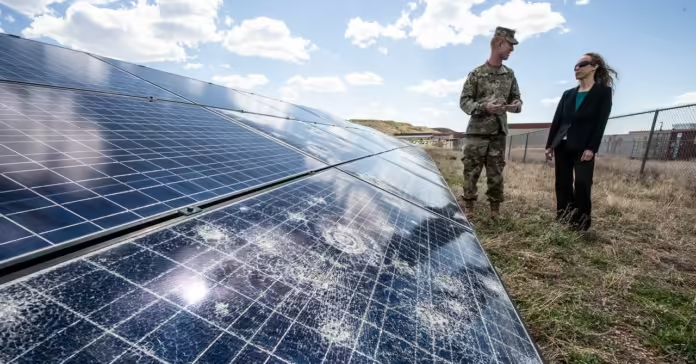This story was originally Featured on Inside Climate News and part of the Climate Desk collaboration.
When baseball-sized hailstones slam into solar panels at speeds of over 90 miles per hour, the results can be disastrous.
We saw this first-hand in March when a hailstorm destroyed parts of the 350MW Fighting Jays solar project in southeast Texas. Images of thousands of panels with round white holes of broken glass circulated on social media and in the news. Right-wing media outlets rushed to cover the phenomenon, which they saw as evidence of the unreliability of solar power.
The reality when it comes to hail and solar panels is more complicated, and no less dire.
Solar developers and manufacturers are taking steps to mitigate the risks of hailstorms, including a combination of advanced weather forecasting and panels that can be rotated to avoid direct hits. I’ve spoken recently with several people working on this effort.
First, let’s clarify the problem: Climate change is contributing to increased intensity of storms, including hailstorms.
At the same time, solar is the world’s fastest-growing source of electricity and is part of the renewable energy sources that are expected to produce most of the world’s electricity by the middle of this century, according to the International Energy Agency.
For now, instances of hailstorms destroying solar power plants, like those in southeast Texas this year and western Nebraska last year, are rare and still notable, but what will happen 20 years from now, when hailstorms are more intense and solar power covers a much larger area?
While there is no perfect way to protect your solar panels from hail, there are ways to reduce the risk.
“There are real mitigation measures in place,” said Renee Vandewege, vice president of weather operations at Minnesota-based DTN, which offers weather forecasts and other subscription products to energy companies.
“We’ve patented the ability to measure hail size with radar technology,” he said, “and we can scan the storm and get feedback that the storm is producing 2-inch diameter hail, or whatever the scenario may be.”
This data is most useful when solar panels have equipment that can adjust the angle of the panels in response to an approaching storm to mitigate damage.
Nearly all utility-scale projects under construction today use trackers, a system that rotates solar panels to follow the sun during the day. Some of these trackers have the ability to go into a “stow” mode, where they will rotate quickly to avoid a direct hit.
For example, Nextracker, a California-based manufacturer of solar tracking systems, sells a hail mitigation product that connects to weather forecasts such as DTN and uses that data to adjust the angle of panels before a hailstorm. The system is operated by software that can be used on-site or remotely, and has a battery backup so it can function during a power outage.
“Will solar continue to be developed and built in hail areas? The answer is yes,” said Greg Beardsworth, senior director of product marketing at NextTracker. “It will happen by understanding the magnitude of risk based on location and selecting the right combination of module technology and tracker storage capacity.”


